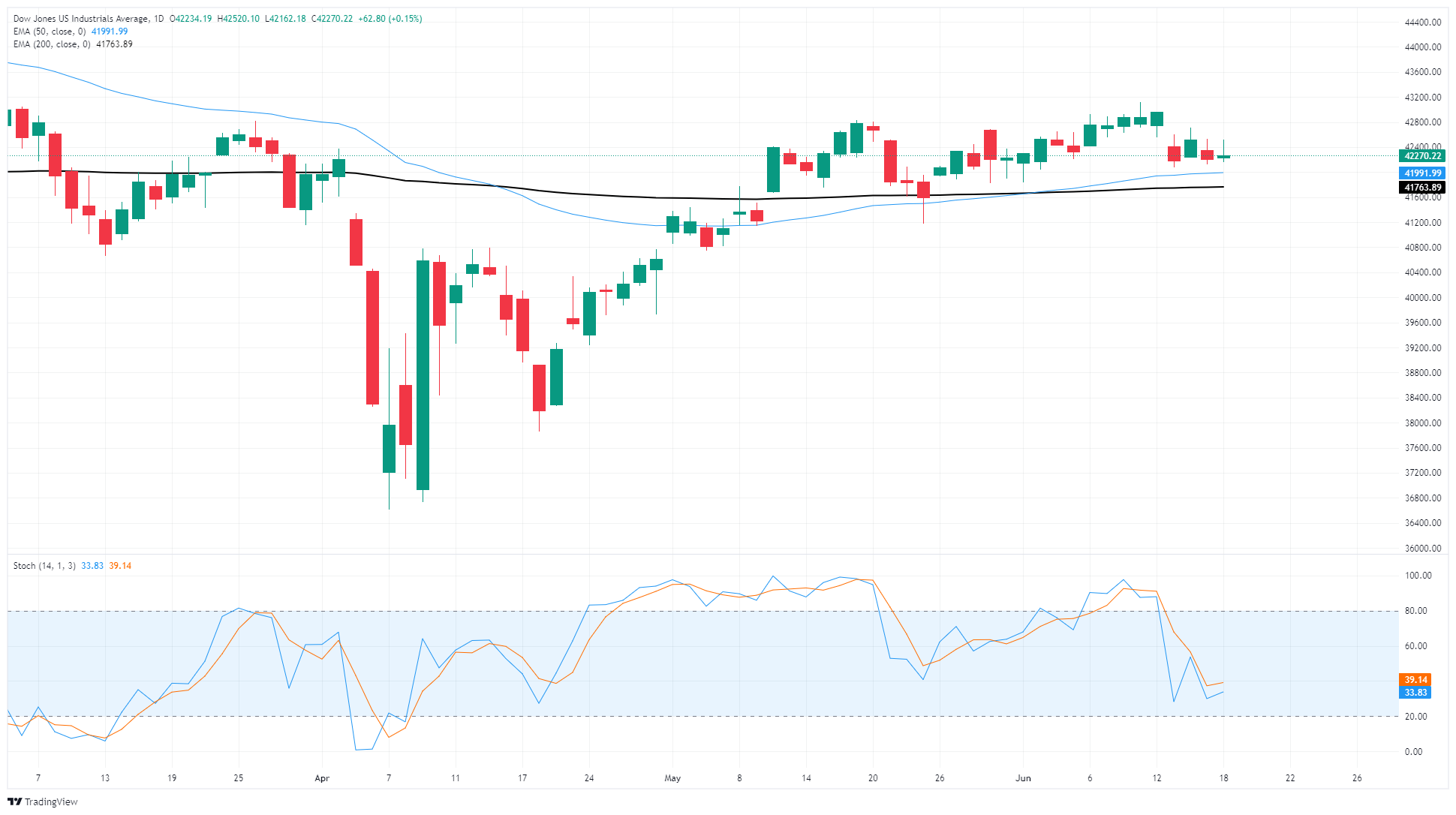Dow Jones Industrial Average swims in a tight circle ahead of Fed rate call
- The Dow Jones is looking to the high side, but is hesitant ahead of the Fed’s latest interest rate decision.
- The FOMC is broadly expected to stand pat on interest rates, and investors will be focused on any changes in policy communication.
- Another rate hold will likely draw more ire from the Trump administration.
The Dow Jones Industrial Average (DJIA) is churning the charts in near-term consolidation, stuck near the 42,350 level as investors hunker down and await the Federal Reserve’s (Fed) latest rate call. The Fed is broadly expected to stand pat on rates until at least September, leaving investors to comb through the Summary of Economic Projections (SEP) and look for any shifts in the wording of policy statements.
The Federal Open Market Committee’s (FOMC) SEP, or “dot plot”, will be updated on Wednesday. Fed policymakers tend to have a high degree of accuracy when forecasting when, and by how much, the Fed will adjust rates, so any shifts in the dot plot will shoot to the top of market attention.
US President Donald Trump will likely be paying close attention to the Fed’s rate call as well. Trump has been ramping up caustic rhetoric against the Fed, and Fed Chair Jerome Powell specifically, in recent months. President Trump is looking for ways to lower the financial burden of US debt servicing, and convincing the Fed to arbitrarily lower interest rates could accomplish that. However, the Fed remains firmly entrenched in a “wait and see” stance as policymakers brace for downside economic impacts from the Trump administration’s on-again, off-again tariff policies.
The FOMC’s latest interest rate decision and SEP update are due at 18:00 GMT. Fed Chair Powell’s follow-up press conference and ensuing Q&A session will begin shortly after, at 18:30 GMT.
Read more pre-Fed stock news: Goldman Sachs, JPMorgan gain on Wednesday ahead of Fed interest rate decision
Dow Jones price forecast
The Dow Jones is churning in a tight midrange, trapped in near-term congestion. The major equity index is caught in a consolidation zone just north of the 200-day Exponential Moving Average near 41,800, and price action is pulling into the midrange with technical oscillators hung in no man’s land.
Dow Jones daily chart

Dow Jones FAQs
The Dow Jones Industrial Average, one of the oldest stock market indices in the world, is compiled of the 30 most traded stocks in the US. The index is price-weighted rather than weighted by capitalization. It is calculated by summing the prices of the constituent stocks and dividing them by a factor, currently 0.152. The index was founded by Charles Dow, who also founded the Wall Street Journal. In later years it has been criticized for not being broadly representative enough because it only tracks 30 conglomerates, unlike broader indices such as the S&P 500.
Many different factors drive the Dow Jones Industrial Average (DJIA). The aggregate performance of the component companies revealed in quarterly company earnings reports is the main one. US and global macroeconomic data also contributes as it impacts on investor sentiment. The level of interest rates, set by the Federal Reserve (Fed), also influences the DJIA as it affects the cost of credit, on which many corporations are heavily reliant. Therefore, inflation can be a major driver as well as other metrics which impact the Fed decisions.
Dow Theory is a method for identifying the primary trend of the stock market developed by Charles Dow. A key step is to compare the direction of the Dow Jones Industrial Average (DJIA) and the Dow Jones Transportation Average (DJTA) and only follow trends where both are moving in the same direction. Volume is a confirmatory criteria. The theory uses elements of peak and trough analysis. Dow’s theory posits three trend phases: accumulation, when smart money starts buying or selling; public participation, when the wider public joins in; and distribution, when the smart money exits.
There are a number of ways to trade the DJIA. One is to use ETFs which allow investors to trade the DJIA as a single security, rather than having to buy shares in all 30 constituent companies. A leading example is the SPDR Dow Jones Industrial Average ETF (DIA). DJIA futures contracts enable traders to speculate on the future value of the index and Options provide the right, but not the obligation, to buy or sell the index at a predetermined price in the future. Mutual funds enable investors to buy a share of a diversified portfolio of DJIA stocks thus providing exposure to the overall index.

